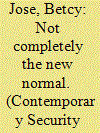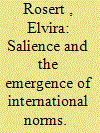| Srl | Item |
| 1 |
ID:
153885


|
|
|
|
|
| Summary/Abstract |
How do human rights groups prevent the normalization of practices they find troubling? Existing international relations research provides insights into how states resist the new norms human rights activists introduce into the global arena. But it tells us less about how governments themselves promote norms and how activists push back against this advocacy. This article explores this issue by examining the interplay between Human Rights Watch (HRW) and the United States around the emerging norm of targeted killing. It argues that Bin Laden’s death opened a window of opportunity for the potential emergence of a targeted killing norm, with the United States as its norm advocate. To prevent its emergence, HRW deployed some of the same strategies states have used to suppress the emergence of norms they dislike. In illustrating these dynamics, this article helps us better understand why some norms rise, why some fall, and why they might change over time.
|
|
|
|
|
|
|
|
|
|
|
|
|
|
|
|
| 2 |
ID:
164437


|
|
|
|
|
| Summary/Abstract |
This article theorises salience – defined as the amount of attention granted to an issue – as an explanatory factor for the emergence and non-emergence of norms, and shows how salience affects existing explanations such as issue adoption by norm entrepreneurs, mobilisation, social pressure, and framing. The relevance of salience is demonstrated by exploring the question of why the norm against incendiary weapons was adopted in the Convention on Certain Conventional Weapons (CCW) in 1980, and why the norm against cluster munitions was not, even though both weapons were deemed particularly inhumane and thus, put on the agenda when the CCW negotiations started in 1978. Drawing on secondary sources and on original data from public and institutional discourses, I study the influence of salience on the emergence of the anti-napalm norm and the non-emergence of the anti-cluster munitions norm in the period of 1945–80. The results demonstrate that and how the discrepancy in salience of the napalm and the cluster munitions issues mattered for the outcomes of the two norm-setting processes.
|
|
|
|
|
|
|
|
|
|
|
|
|
|
|
|
| 3 |
ID:
121424


|
|
|
|
|
| Publication |
2013.
|
| Summary/Abstract |
This article provides a systematic understanding of international norm emergence and illuminates the various strategic pathways to altering global dialogue and standards of practice. It traces the steps leading to global norm emergence and identifies the range of conditions that are necessary or sufficient for potential norms to move from one step to the next. Accordingly, it analyzes the progress of six separate international norm agendas to develop a more systematic understanding of the process of global norm creation, which can be applied to fledgling efforts to establish a new regime of international migrants' rights. Based on this examination, it introduces a typology that categorizes the stages of norm development and the range of possible outcomes.
|
|
|
|
|
|
|
|
|
|
|
|
|
|
|
|